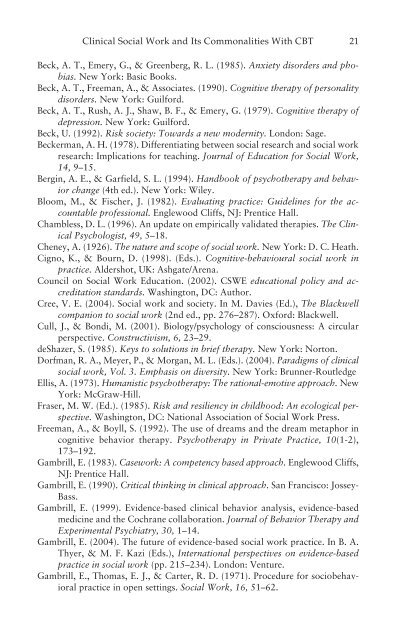Tammie Ronen, PhD - Springer Publishing
Tammie Ronen, PhD - Springer Publishing
Tammie Ronen, PhD - Springer Publishing
You also want an ePaper? Increase the reach of your titles
YUMPU automatically turns print PDFs into web optimized ePapers that Google loves.
xxvi<br />
INTRODUCTION<br />
TREATING CHILDREN, ADOLESCENTS,<br />
FAMILIES, COUPLES, AND GROUPS<br />
In Part II, we address treatment across the lifespan. Nowhere is the social<br />
part of the term social worker more essential and vital than when dealing<br />
with clients’ problems with coping deficits. Given that we live within social<br />
contexts, the problems of groups and families seem obvious areas for<br />
the social work practice. The bidirectional interactions of couples and the<br />
tri-, quad- or pentadirectional interactions that occur within groups and<br />
families make this area of treatment far more complex than it might appear<br />
on the surface. Children and adolescents must be treated within<br />
their family, school, cultural, and religious systems. The systems are the<br />
agencies that have helped create and maintain schemas and need to be addressed<br />
if any schematic modification is to occur (or if the modification<br />
will be maintained). One therapist speaks of how not paying necessary<br />
homage to the powerful and controlling mother of a 16-year-old client led<br />
to the eventual sabotage of the therapy, the withdrawal of the client from<br />
therapy, and the return of the presenting symptoms. It is unusual for<br />
child or adolescent clients to seek therapy. School social workers, by<br />
virtue of their work venue, are more likely to have “walk-ins” who have<br />
had a personal or social crisis, are experiencing overwhelming emotions,<br />
or have recognized the need to speak with a nonjudgmental adult. Few<br />
clinical social workers in institutional or private practice settings get these<br />
same referrals. The work with children and adolescents is further complicated<br />
by the need in many settings for parental approval of the treatment<br />
beyond an initial referral screening. A key ingredient stressed<br />
throughout this area of treatment is how one builds the client’s active<br />
collaboration and participation in the treatment. The issue is not only<br />
how to develop motivation for change but to maintain that motivation<br />
through the demanding times of treatment. <strong>Ronen</strong> (Chapter 9) makes the<br />
point that the clinician needs to identify areas and issues that the client is<br />
willing and able to work toward changing. Further, she states, “CBT<br />
looks for and increases clients’ support systems, strengths, and resources<br />
and helps them to help themselves.” As DiGiuseppe states, “Children are<br />
not so much disturbed, but are more often disturbing to others” (1992,<br />
personal communication). Children and adolescents find themselves in<br />
conflict with their families and in their school settings. Their difficulties<br />
may be based on their frequent aggressiveness with peers, academic underachievement<br />
(or failure), misuse of drugs, or impulsive or apparently<br />
reckless behavior. We have all seen or experienced a child who is acting<br />
out in the classroom through some externalizing behavior. A particular<br />
teacher or educational system is motivated and trained to cope with<br />
this child. The same behavior in another classroom or setting creates a

















